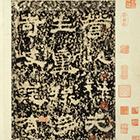Asian Gallery (Toyokan) Room 8
February 4, 2014 (Tue) - April 6, 2014 (Sun)
While being active as a Western-style painter, Nakamura Fusetsu (1866–1943) also sold his paintings to collect cultural properties related to calligraphy. The items he gathered over 40 years from the mid-Meiji era onward form a unique, wide-ranging collection of objects deeply connected to calligraphy. The collection of over 10,000 items contains many masterpieces known around the world. In 1936, Fusetsu founded a calligraphy museum in Tokyo. After his death, the museum was maintained by the Nakamura family until they donated it to Taito ward in Tokyo in 1995. It reopened as the Taito City Calligraphy Museum in 2000, since when it has continued to serve many calligraphy scholars and enthusiasts.
Takashima Kikujiro (1875–1969), who was the president of Oji Paper Company, began collecting calligraphy and paintings in his thirties, while continuing his business activities. Many of his collected masterpieces and famed rubbings, dating from the Song and Yuan dynasties (960–1368) to the Ming and Qing dynasties (1368–1912), were quickly listed in catalogues and other publications. In this way, Takashima played an immeasurable role in the development of this field. In 1965, when Takashima was 90 years old and the Toyokan (Asian Gallery) at the Tokyo National Museum was nearly built, he donated over 200 selected items from his collection to the museum. Even today, these items are displayed at the museum as representative masterpieces of Chinese calligraphy.
Through the objects collected by Nakamura Fusetsu and Takashima Kikujiro, who created global collections from the Meiji and Taisho eras to the Showa era, visitors can glimpse the attraction and depth of Chinese calligraphy.

